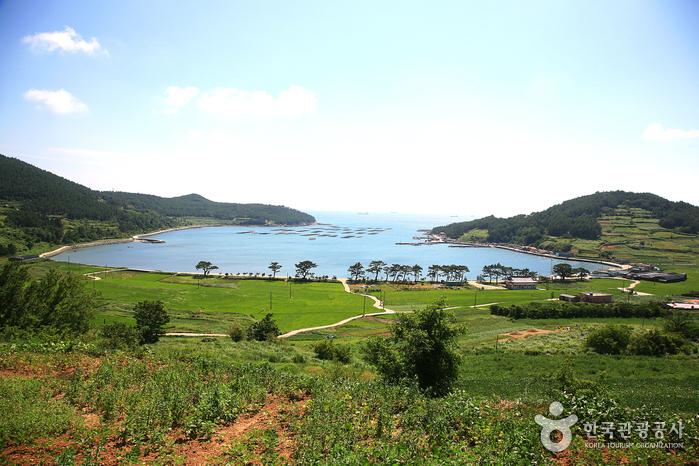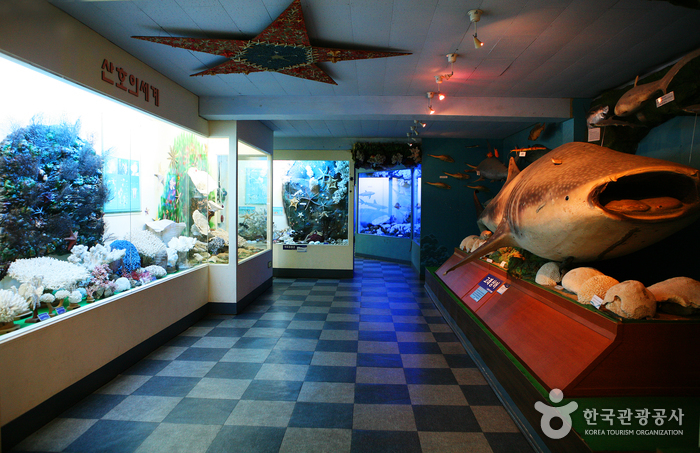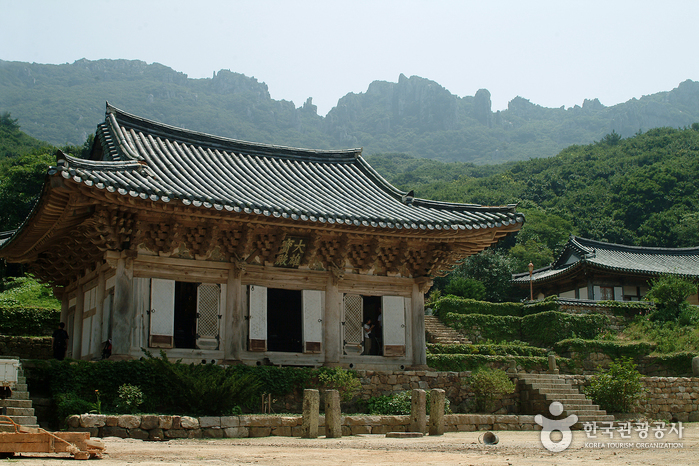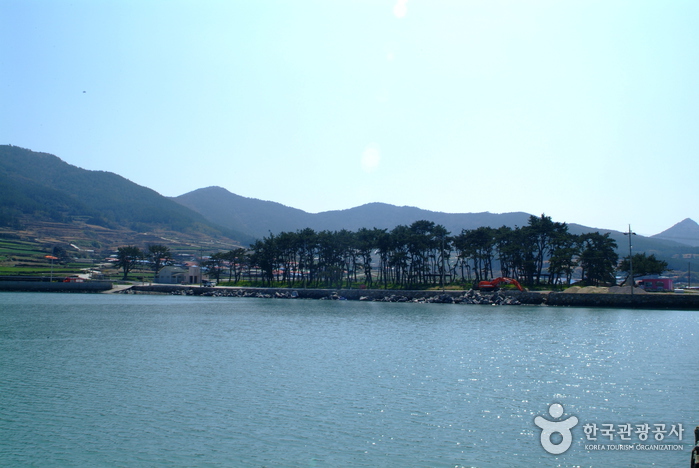Île Cheongsando (청산도)
16.4Km 2020-06-11
19-3 Docheong 4-gil, Cheongsan-myeon, Wando-gun, Jeollanam-do
+82-61-550-5151
Toute l'île de Cheongsan-faire fait partie du Parc National Maritime de Dadohae. C’est la plus grande des 14 îles de Cheongsan-myeon (Wan-do) ; elle s'étend sur 33,28 kilomètres carrés avec un littoral long de 42 kilomètres. Connu pour ses eaux cristallines, l'île est propice à la détente plutôt que des activités dynamiques. Un taxi ou un bus permet de visiter l'île en 2/3 heures et il est possible d’y rester une nuit pour admirer le soleil couchant sur la mer. L'île est à 50 minutes en ferry de Wando Terminal. Elle a été rendue célèbre avec le film coréen Sopyonje, un opéra traditionnel coréen. Durant le tournage, le réalisateur Im Kwon-taek souhaiter montrer un village traditionnel épargné de la modernisation. Comme on le voit dans le film, l'île offre un paysage merveilleux le long des routes étroites et sinueuses, des murets en pierre, et des terrasses de rizières très vertes.
Le village de Dangni est à peine trois minutes en bus ou 10 à 15 minutes à pied du ferry terminal. Ici, vous trouverez des murs de pierre et les maisons aux toits de chaume vu dans Sopyonje. Les murs de pierre rappellent la scène où le père, la fille, et le fils marchaient le long des murs chantant «Jindo Arirang ». Les maisons aux toits de chaume étaient l’endroit où le père enseignait sa fille à chanter. Vous pouvez également monter sur la colline qui offre une vue magnifique sur la mer. C’est certainement le plus beau point de vue sur Cheongsando.
La plage Jiri dispose de sable blanc qui s'étend sur 1,2 km et des grands pins qui l'entourent comme un paravent. C’est la meilleure plage de la meilleure plage de Cheongsan-do et le coucher de soleil y est merveilleux. Avec ses eaux propres et peu profondes, la plage Jiri est aussi un lieu de loisir idéal pour les familles, où l’on peut se reposer sous l’ombre des vieux pins et se relaxer au soleil. Le soir, vous pouvez admirer l'horizon changer de couleur. Les installations comprennent des toilettes, des douches, et un magasin de restauration rapide.
Musée d’histoire naturelle marine de Ttangkkut (땅끝해양자연사박물관)
17.8Km 2021-03-17
5-4, Jungdaedong-gil, Songji-myeon, Haenam-gun, Jeollanam-do
+82-61-535-2110
Moitié aquarium, moitié musée, le musée d’histoire naturelle marine de Ttangkkut se situe à l’extrêmité la plus au sud de la péninsule coréenne, dans le village de Ttangkkeut Maeul à Songji-myeon, Haenam-gun. Lim Yang-su, le directeur du musée, a collecté la plupart des pièces du musée en parcourant le monde durant ses 13 ans de service comme capitaine d’un bateau de pêche en haute mer. Parmi les objets exposés se trouvent des artefacts et des spécimens vivants, tous ayant fait l’objet de recherches et ayant été classés par une équipe d’experts.
Le musée a pour but de motiver les gens à explorer, observer, et préserver la nature en stimulant la curiosité des visiteurs à travers des répliques miniatures de la vie marine. On y trouve environ 25 000 spécimens, parmi lesquels des coquillages, du corail, des poissons, des mammifères, des crustacés, des fossiles, des reptiles et des insectes du monde entier.
Haemaru healingsoup [Korea Quality] / 해마루 힐링숲 [한국관광 품질인증]
18.3Km 2020-12-12
108-35, Donghae-gil Bukpyeong-myeon, Haenam-gun, Jeollanam-do
+82-10-2332-6303
'Haemaru Healing Forest is a guesthouse situated at the foot of Duryunsan Mountain, Haenam in front of Wondo Beach and surrounded by a cypress grove. The mountain, cypress grove, and beach are all visible from the main floored hall room. For this reason, many of the guests who stayed here say that the picturesque view seems to change day by day. The town where the guesthouse is located is specially designed as a 'hanok village,' consisting mostly of traditional Korean houses of Jeollanam-do. It is also widely known as 'Haenam Kimchi Village' because of their famous cabbages, which are grown in the natural environment and are used to make kimchi. Specifically, there are three villages in this area: 'Green Experience Village,' 'Farm Stay Village,' and 'Resort Village.' There is a public swimming pool in the area managed by the villagers and is very popular among visitors, with ticket sales reaching KRW 100,000,000 a year. One of the advantages of staying at this guesthouse is that it’s within a one-hour ride to a number of popular nature destinations such as Wando Cheongsando Island, Gangjin Dasan Chodang, Jangheung Cheongwansan Mountain, Woodland, and Yeongam Wolchunsan Mountain. Haenam is known as one of the best regions of Korea for enjoying the famous Jeolla-do cuisine, so visitors to Haenam are advised to try the local food. The villagers built these traditional Korean guesthouses so that their visitors can have a day of relaxation in nature, away from their hectic city life. With this mind, they used natural pinewood and red clay from Gangwon-do to build authentic traditional Korean houses and utilized traditional Korean tiles from Goryeong. The name 'Haemaru Healing Forest' was given by the owner of the guesthouse, with the subtitle 'A place where you can tell your story.' The guesthouse buildings are in 'ㄱ' shape. The main building, called 'anchae' in Korean, has floor area of 72m², which is big enough for up to 25 people. There are two rooms, a large living room, and a kitchen in this building. The rooms are furnished with sofa, television, air conditioner, refrigerator, and table just like an ordinary home so that guests can feel at home during their stay. The 'bakkatchae,' or 'detached house,' is a single room with capacity of 6 and is furnished with air conditioner and bathroom. The guesthouse is owned by a couple who still work in Seoul and need to travel back and forth between Seoul and Haenam frequently. They're both nature lovers, so their most favorite place in the house is the kitchen garden where they cultivate their own organic lettuce, perilla leaves, and chili peppers. The kitchen garden is open to guests who want to try the homegrown organic vegetables. Various experience programs are offered here as well, such as yunnori, dadeumi, jwibulnori, and kimchi making. Jwibulnori is a traditional Korean game played on the eve of Daeboreum or First Full Moon Day, where people burn dry grass on the ridges of rice paddies and fields and others spin cans of flames attached to the end of a stick or a sling. For safety reasons, this game is played with the consent and participation of the villagers, so be sure to ask the owner of the guesthouse when the game is played. It’s free for groups of more than 10 people. As for the kimchi-making class, it is offered by the guesthouse owner's younger brother and sister-in-law who live and run a kimchi factory in the village. They will teach you how to make kimchi, step-by-step, start to end. The kimchi-making class is a paid program, so be sure to ask the guesthouse owner how much and when the class is held.
Temple Mihwangsa (미황사)
18.5Km 2021-08-10
164, Mihwangsa-gil, Songji-myeon, Haenam-gun, Jeollanam-do
+82-61-533-3521
Construit pendant la huitième année du règne du Roi Gyeongdeok de la Dynastie Shilla (749), le temple Mihwangsa est situé sur le flanc gauche du mont Dalmasan (489m), à l’extrême sud de tous les temples de la péninsule coréenne. Le beau coucher de soleil et la vue du mont Dalmasan à partir du temple attirent de nombreux touristes.
Plage de Sinheung (신흥해수욕장)
18.9Km 2024-12-18
Sinheung-ri, Cheongsan-myeon, Wando-gun, Jeollanam-do
+82-61-550-6493
La plage de Sinheungni se trouve à l’extrêmité du port de Cheongsanhang sur l’île de Cheongsando. Cette plage en pente douce s’étend sur 2 km (à marée basse) et possède une grande vasière où l’on trouve des quantités de palourdes. La plage de Sinheungni est une destination estivale populaire auprès des familles qui viennent faire du camping ou du caravaning. La vieille pinède qui borde la plage sert non seulement de coupe-vent, mais elle permet également de s’abriter à l’ombre pour échaper à la chaleur de l’été.
Seoladawon [Korea Quality] / 설아다원 [한국관광 품질인증]
19.9Km 2023-04-13
153-21, Samseong-gil, Bugil-myeon, Haenam-gun, Jeollanam-do
+82-61-533-3083, +82-10-7616-6129
Located at the foot of Mt. Duryunsan in Haenam, Jeollanam-do Province, Seola Dawon is committed to preserving and inheriting the tea culture and nature of the region. The owner began to cultivate this place after hearing the concerns about the absence of a person who would inherit the tea culture of this region from a Buddhist monk he met at Iljiam Hermitage of Daeheungsa Temple in Haenam in 1996. Meanwhile, nine young men who studied tea together cultivated the green tea field in Haenam and built houses. After that, people who had affection for teas began to visit Seola Dawon. Since there were no decent accommodations for people who came from afar, they built eight Korean traditional-style houses in all including a Sarangbang made with stones, the earthen house, the wall-frame house, and the earthen bag house. The Korean traditional-style house was built in 2003 as a cultural space and later remodeled into rooms for the operation of Hanok Stay.


![Haemaru healingsoup [Korea Quality] / 해마루 힐링숲 [한국관광 품질인증]](http://tong.visitkorea.or.kr/cms/resource/35/2049835_image2_1.jpg)


![Seoladawon [Korea Quality] / 설아다원 [한국관광 품질인증]](http://tong.visitkorea.or.kr/cms/resource/63/2584863_image2_1.jpg)
 Français
Français
 한국어
한국어 English
English 日本語
日本語 中文(简体)
中文(简体) Deutsch
Deutsch Español
Español Русский
Русский